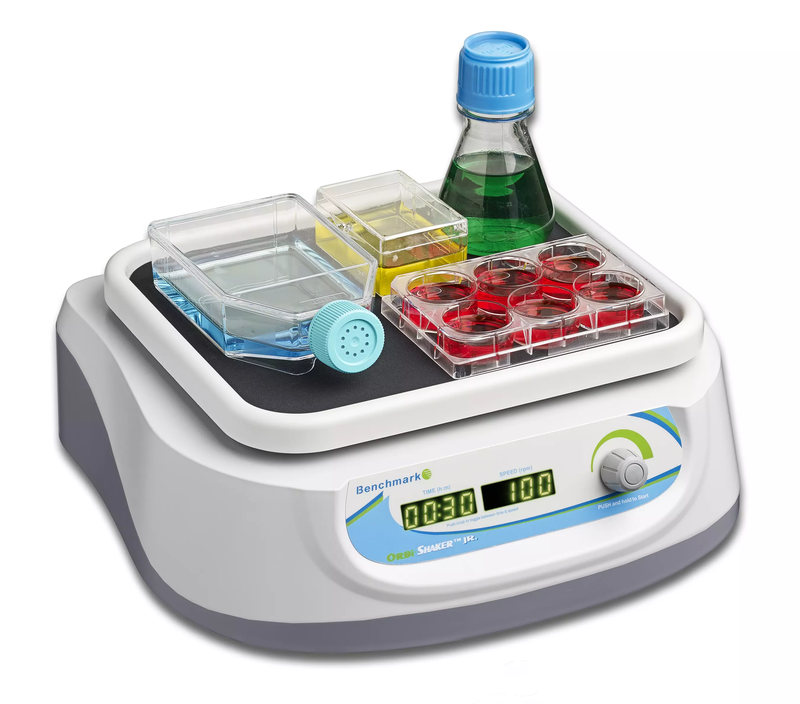How to Select the Right Orbital Shaker for Your Laboratory
February 18 2018 /
The orbital shaker is useful for research work in the field of physics and biology. The laboratory equipment is useful for culturing microbes, agitating substances and general mixing and blending.
Shakers come in various sizes, textures, and formats, which makes it confusing to decide which one is best suited to your laboratory. To help you narrow your options down, it is important that you answer the questions below.
What type of vessels will you be shaking?
It is important that you list out all the labware you will need to shake. There is a variety of attachments and clamps available to meet every application's need.
Oddly shaped vessels like media bottles and volumetric flasks require an adjustable vessel platform with roller bars to keep them in place. There are adhesive tapes and mats available to accommodate various vessel sizes with slow speed applications less than 250 rpm.
What orbit diameter is best suited for your laboratory?
Once you've determined the type of vessel(s)you will be shaking, you can decide on the orbit diameter of the shaker. The diameter of the orbit is an important factor that is often overlooked when purchasing a shaker.
Some vessels and culturing applications are better suited to specific orbit sizes. This is because circulation and aeration of your growth medium are directly affected by the size of the shaker's orbit.
Most shakers on the market have a 2.5 cm and 5.1 orbit diameter. A 2.5 cm orbit is the standard option for most applications, but experiments greater than 2 liters or containing shear sensitive cells, will benefit from an orbit with a larger diameter.
While, small orbit diameters less than 1 cm are best for microcentrifuge tubes, microplates, and other extra small vessels.
Do you want to shake multiple types of vessels at the same time?
Most manufacturers have created platforms designed specifically to shake only one vessel size, like a flask. Such platforms provide maximum capacity and have clamps already installed.
Universal platforms, on the other hand, provide maximum flexibility for using labware of different sizes on a single platform. It comes with mounting holes that allow you to add and interchange test tube racks and clamps as you need.
Additional platforms may be beneficial if several individuals will be using the same shaker.
What shaking speed do you require?
Some units will shake as fast as 500 rpm, while others shake as slow as 15 rpm. The range of speed varies depending on whether the user interface is digital or analog. Digital orbital shakers typically offer better speed accuracy than analog models. Speed can also be limited if the unit is stacked.
What temperature range do you require?
It is important to get an orbital shaker that offers the temperature range you need to meet specific growth requirements.
For example, some orbital shakers that are used to grow thermophiles will go up to 80ºC. While units that are used for protein expression applications are refrigerated models that are can lower to 4ºC.
How much weight will be placed on the shaker?
All orbital shakers have weights limits. If a heavy workload is to be placed on the shaker, consider a model with a triple eccentric drive mechanism. Single eccentric drive mechanisms are better suited to lighter workloads.
Once you have answered the questions above you should have a good idea of what you need in a shaker. Below is a simple guide to the basic orbital shakers types available.
Open air benchtop orbital shakers
These shakers tend to be the cheapest priced available. They have no temperature control so are perfect for experiments that only need ambient temperatures like staining, extraction procedures, some solubility studies, and washing procedures.
These shakers operate in humidity conditions from 20% to 80%, making them useful in warm rooms, incubators, refrigerators, and environmental chambers. Some open-air benchtop shakers are not suitable for use in C02 chambers.
Refrigerated/incubated floor and benchtop orbital shakers
These shakers are more versatile than open air orbital shakers. They provide a wide variety of temperature options, such as refrigeration, incubation, and ambient. These shakers are also available in a variety of sizes.
Digital or analog shaker?
There are many differences between these two user interface types. Analog orbital shakers are a cheaper alternative to digital models, but they also tend to have a more limited speed range than digital.
Analog shakers tend to require maintenance annually, while the digital models are considered maintenance-free. This can be owing to the brushes in the motors of some analog systems that need to be replaced.
Digital shakers also contain more features than analog models. These range from temperature and speed alarms to the ability to transfer data to a computer.
There is a wide variety of orbital shaker options available. Selecting the most suitable unit for your laboratory is important, so consider the questions above and review the available options before you make your purchase.
